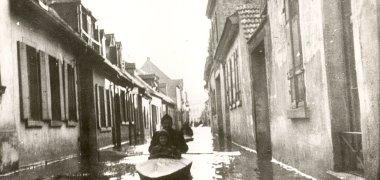
Deutsche Version Version Française
The city archive of Speyer is the oldest local archive of the Palatinate (Pfalz) region. The earliest document held in the archive is a certificate of Emperor Frederick I. Barbarossa from 1182, in which the famous privilege of Speyer which was given by Emperor Henry V. in 1111 was affirmed and expanded. The city archive of Speyer is one of the oldest agencies in Speyer. Its tradition goes back to the period of imperial towns: already in the Late Middle Ages it was stipulated that the city’s certificates should be kept in arks. In 1454 the papers and documents of the imperial town should be provided “mit gewelbe”; a red ark was provided for particularly valuable privileges, like the certificates of kings and emperors. The oldest register of the archive (Repertorium) tells us that the files were divided in arks with the letters from A to Z and from AA to RR. Although the city archive suffered a certain of a loss in early modern history (due to the town fire of 1689), it is one of the most significant local archives in Germany in view of its tradition dating back to the period of imperial towns.

From 1726, the city archive of Speyer was situated in the then newly inaugurated townhall. The historical archive room with its transportable wall closets is still preserved today and has served as a marriage venue for the Registrar’s office for some years. Some archivists from the Bavarian “Kreisarchiv” Speyer looked after the city archive from 1892, most recently Anton Doll (1949-1963). Back in March 1995 the city archive moved to the former building of the “Pfälzische Landesbibliothek” in the Johannestraße 22a. The advantages of this move were sufficient storage capacity, office rooms and especially a large reading room.
Tasks
Unlike libraries and museums, which expand their collection systematically, archives grow steadily as a result of the documents handed in by the city’s agencies. The city archive of Speyer has a proven formula for the transfer of tradition into the future, especially for future research and judical certificates. In this way it protects the law and fulfils the tasks of the city administration. Its main tasks are selection and acceptance of documents for long-term preservation and finally their improvement. The archive also presents and imparts the history of the city. First and foremost it is the historical center of excellence and retention of the city. On this account, the archive participates in exhibitions, provides tours, and contributes to the research of the city through lectures and publications.

The city archive also holds an enormous amount of non-official documents like personal papers, documents of associations, newspapers, photos, photo postcards, plans, placards, movies and so on. There’s a reference library too.
The city archive participates in the DFG-project “Virtuelles deutsches Urkundennetzwerk”. In this context, all charters will be digitalized and access provided in the virtual archive “Monasterium” on the internet. The archive takes part in the EU-project “European network on archival cooperation” (“ENArC”) as an associated partner. The short- and middle-term aims are the presentation of finding aids and documents (e.g. archival holdings) on the web and at the digital reading room and also the steady enhancement of public perception of the archive as memory of the city.
(Text/Translation: Nico Seifert; many thanks also to Anna McNally)


